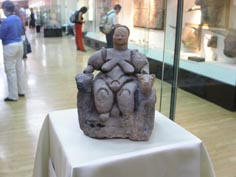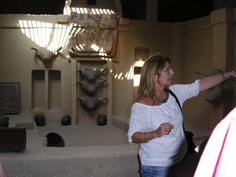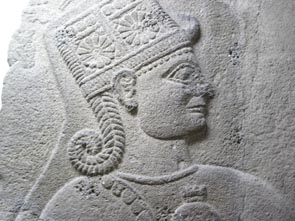|
9/10 Day Four
Overnight
sleeper train to Ankara. Left at 10 pm. Our group had the whole car. Really
fun. Arrived on time at 8:04 am.
 Went to
the Museum of Anatolian Cultures. Ankara means “deep gorge” where the oldest
settlement was. Meli says that this is the best archeological museum in the
world. It was built in the 15th century where caravans came to
market their goods. It reflects 28 civilizations. There was no Ice Age,
inner sea, floods, etc to wipe out earlier civilizations. Went to
the Museum of Anatolian Cultures. Ankara means “deep gorge” where the oldest
settlement was. Meli says that this is the best archeological museum in the
world. It was built in the 15th century where caravans came to
market their goods. It reflects 28 civilizations. There was no Ice Age,
inner sea, floods, etc to wipe out earlier civilizations.
Meli gave
us an overall introduction:
The first
city state in Anatolia found so far is Catalhoyuk. It is from the Neolithic
era. They designed their own environments, had seals (shows sense of
ownership), and a pyramid of social structure. At the top was the divinity =
mother goddess.
People
evolved similarly all over the world. Some became more powerful based on
availability of resources. City-states grew into kingdoms and empires. The
Hittites came from Ham, son of Noah. The daughter of Egyptian Ramses II was
married to a Hittite. 1785 BC was the first written treaty.
After the
Hittites came kingdoms. Gordion
(near Ankara) was the capitol of the Freg Cag kingdom. King Midas 900 BC –
500 BC turned everything to gold because of his greed. He turned his own
daughter into gold and then asked the gods to forgive him. Midas took the
Phoenician alphabet and made it into Greek letters. Before there had been
cuneiform symbols. They worked in wood and metal. A second kingdom St Paul and Luke headed west. Hannibal of
Cartage took elephants
to Gibraltar and then to the Alps on his way to Rome. He was given a city. A
third kingdom was Troy. Fourth kingdom was Lydia “as rich as Croesus” who was the king.
Sardis was the capitol built on the Paktolos River with gold. He was
obsessed by it.
 In 615
BC, he used inferior metals to mint coins reflecting the value of his gold
treasury. In 580 BC, the Persians wiped out these kingdoms. After the fall
of the Persians, came the Pergamon Empire, then the Roman Empire followed by
Byzantine, Turks, Mongols, Ottoman Empire and finally the Turkish Republic
in 1923. In 615
BC, he used inferior metals to mint coins reflecting the value of his gold
treasury. In 580 BC, the Persians wiped out these kingdoms. After the fall
of the Persians, came the Pergamon Empire, then the Roman Empire followed by
Byzantine, Turks, Mongols, Ottoman Empire and finally the Turkish Republic
in 1923.
Paleolithic Era 2,300,000 – 10,000 BC
Houses
were built of adobe with no gates. You entered through holes in the
ceilings. Elevated spaces in the houses were due to the burial of bones of
the dead. When the space was full, they filled in earth. Bull was the symbol
of power. Had graphic designs – polychromatic 10,000 BC. Had a city plan.
First woven materials were found. A goddess was found in Georgia. Worshipped
goddess related to desire for fertility and prosperity. Sense of ownership
evolved. Seal designs 10,000 BC. Used in kilims, wooden blocks, red pots
through burnishing before firing. In 7,000 BC, learned about making colored
pottery. Developed shiny black pottery through double firings. Developed a
spindle; had metal work (made a crown, code of arms and scepter). Had a
symbol which later the Nazis used which is of two rivers meandering and
crossing at the center (prosperity). See evidence of a dam. Made gold
jewelry, bronze axes as weapons indicating a turning to war. Also had
trading between the Assyrians and Hittites (caravans, markets, required
writing in 2,200 BC and had installment payments). Hittites forbid a trader
from acquiring a second wife in his travels.
Hittite
fresco indicates musicians with guitars, tightrope walkers, blowing fire, a
king and queen; “angora” is from Ankara goats; a sphinx; a high level person
offered a rose; killing and soldiers uprising; mother goddess comes back
holding a pomegranate during the period of city states. there is a man
killing a snake in Capadocia which later becomes St. George. Used chariots
for hunting; buried their possessions 2,700 years ago.
Kingdom
of Urartians used bronze 1,000 BC; used horses in war; had a fork for hay
Lunch was
salad and doner (special thin meat with tomato sauce, hot melted butter over
bed of crispy bread chunks) and yogurt on the side.
Stopped
to see the Mausoleum of Ataturk. Saw his tomb but not the museum.
Began a
4.5 hour bus trip (with Hasan as our driver in a smaller bus) to Capadoccia.
Stopped after 3.5 hours. Meli gave each of us special Turkish spicy pizza.
During
the Ottoman Empire, an honest man was chosen “big brother” to keep the
census and to collect produce tax. He would also get some for his work on
behalf of 30 villages. Rulers of Kuwait selected by 1740s. The system became
corrupted and it became a hazard for democracy. Post 1923, 1962 Land Reform
became a problem for big brothers using claim as deeds to land. Government
bought land from them at the declared value of the land from the past 5
years. Land was sold to people living on it via the Agricultural Bank.
Result is no starving people or homeless people. Clustered housing to free
up arable land. Also had agricultural reform which emphasized cooperatives
eg olive oil coop. Anti-monopoly law so that there are no big farms.
Tradition of
parents building houses for their children.
|
![]()
